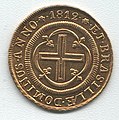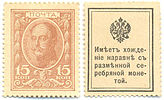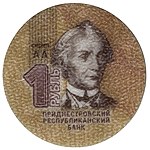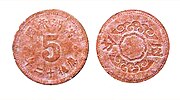Coinage metals
| Part of a series on the |
| Periodic table |
|---|
|
The coinage metals comprise, at a minimum, those metallic chemical elements which have historically been used as components in alloys used to mint coins. The term is not perfectly defined, however, since a number of metals have been used to make "demonstration coins" which have never been used to make monetized coins for any nation-state, but could be. Some of these elements would make excellent coins in theory (for example, zirconium), but their status as coin metals is not clear. In general, because of problems caused when coin metals are intrinsically valuable as commodities, there has been a trend in the 21st century toward use of coinage metals of only the least exotic and expensive types.
History[]
Historically, most coinage metals (or alloys) are from the three nonradioactive members of group 11 of the periodic table: copper, silver and gold, the copper usually being augmented with tin and often other metals to form bronze. Gold, silver and bronze or copper were the coinage metals of the ancient world, and most medieval coins.
All western histories of coins begin invention at some time slightly before or after 700 BC, in Aegina Island,[1] or, according to others, in Ephesus, Lydia, 650 BC.[2] Ancient India in circa 6th century BC, was one of the earliest issuers of coins in the world.[3]
Since that time, coins have been the most universal embodiment of money. These first coins were made of electrum, a naturally occurring pale yellow mixture of gold and silver that was further alloyed with silver and copper.
However, the Persian daric was the first gold coin which, along with a similar silver coin, the siglos, (From Ancient Greek σίγλος, Hebrew שֶׁקֶל (shékel)) represented the bimetallic monetary standard of the Achaemenid Persian Empire which has continued till today.[4] The Persian coins were also very well known in the Persian and Sassanids era. Most notably, in Susa and in Ctesiphon.
However, there are many more, even for coins made from intrinsically precious metals. Precious metals are always used in bullion coins and some collectable coins. Coins not intended for circulation or for intrinsic value have also been made experimentally using an even larger variety of metals, since they function as fiat money. In general coins intended for circulation must have metal values considerably less than their face values, for reasons discussed below.
Requirements for a coinage metal[]
Coins that are intended for circulation have some special requirements based on the conditions they will encounter. For example, a coin may be in circulation for up to 30 years, and so must have excellent wear resistance and anti-corrosion properties. Achieving this goal necessitates the use of base metal alloys. Some metals like manganese have occasionally been used in coins, but suffer from making the coins too hard to take an impression well (or metals apt to wear out stamping machines at the mint).
When minting coins, especially low denomination coins, there is a risk that the value of metal within a coin is greater than the face value. This leads to the possibility of smelters taking coins and melting them down for the scrap value of the metal. Pre-1992 British pennies were made of 97% copper; but as of 2008, based on the price of copper, the value of a penny from this period is 1.5 new-pence. Modern British pennies are now made of copper-plated steel. For similar reasons, American pennies (cents) were once made of copper alloys, but since 1982 have been made of copper-plated zinc.
This problem has led to nearly the end of use for a common base metal alloy for everyday coinage in the 20th century, called cupronickel, with varying proportions of copper and nickel, most commonly 75% Cu 25% Ni. Cupronickel has a silver color, is hard wearing and has excellent striking properties, essential for the design of the coin to be pressed accurately and quickly during manufacture. In the 21st century with the prices of both copper and nickel rising, it has become more common to experiment with various alloys of steel, often stainless steel. For example, in India some coins have been made from a stainless steel that contains 82% iron, 18% chromium, and many other countries that have minted coins that contain metals now worth nearly the coin face-value, are experimenting with various steel alloys.
Chemical elements used in circulating coins[]
This list is incomplete; you can help by . (May 2021) |
| Element | Example usage |
|---|---|
| Aluminium | First issued 1907 for circulation by East Africa & Uganda Protectorates, though earlier patterns exist |
| Antimony | Used in Guizhou, China 10 cents coin of 1931. Used in medallion medal alloy |
| Carbon | In all steel and iron coins. A few "pressed galvanic coal" Notgeld coins were minted in the hyperinflation in post WW I Germany |
| Chromium | Used for plating coins and in some rare hard stainless steel coins |
| Copper | Many coins throughout history were made of gold, silver and copper |
| Silver | |
| Gold | |
| Iron | From 1942 through 1952, some of the Swedish krona coins – such as the 1, 2 and 5 öre – were iron |
| Lead | |
| Manganese | Some Mn used in US wartime "silver nickels" and the new US dollar coin for similar reasons – attempts to match magnetic and electrical properties of previous nickels, and previous Susan B. Anthony dollars, for vending machines |
| Magnesium | Magnesium-aluminum coins were issued in 1943 for the Lodz Ghetto mark in Poland, and are used in India |
| Nickel | Used in alloys since antiquity. The first pure nickel coin was the Swiss 20 Rappen of 1881 |
| Platinum | Russia 3, 6, and 12 ruble coins of Nicholas I issued 1828–1845 |
| Tin | |
| Zinc |

An aluminium token coin from the 1887 American Exhibition in London. At the time, aluminium was complex to produce and more valuable than silver

A 1950 iron Swedish krona coin, with face value of 5 öre

An 1812 gold 4000 réis coin from colonial Brazil

Silver drachma from the island of Aegina, after 404 BC

A 1614 copper double tournois from France
Non-circulating[]
Chemical elements used in non-circulating (commemorative, demo, bullion or novelty) coins, medals, patterns, and trial strikes:
- Cadmium (1828 medal made by G. Loos for the marriage of Heinrich von Dechen, "of Silesian cadmium"[5])
- Cobalt (2005 Cameroon 750 CFA francs struck in cobalt-plated iron.)
- Hafnium ( demo coin.)
- Iridium (2013 1⁄25 oz 10 franc bullion coin issued by Rwanda as part of "Noble Five" precious metals set.)
- Molybdenum (Demo coin – ) (Mintage 250-1 tr oz coins 2008 by Coins By Design – Murray Buckner.)
- Niobium (Austria has issued a number of bimetallic 25 euro coins with a niobium center.)
- Palladium (First issued 1966 by Sierra Leone. Also presentation sets from Tonga, bullion coins of various countries.[6])
- Rhenium ( fantasy pieces – Pope Matthew Triple Ducat and Malvinas 5 Australes)
- Rhodium (2014 1⁄25 oz 10 franc bullion coin issued by Rwanda as part of "Noble Six" precious metals set. Also Cohen Mint bullion round.)
- Ruthenium (1967 1⁄2 Hau from Tonga was 98% palladium and 2% ruthenium)
- Selenium (1862 medal in UK Science Museum, commemorating Berzelius, discoverer of the element.)
- Silicon (Privately struck US quarter patterns dated 1964 (Pollock-5380) in nickel-silicon alloy.)
- Tantalum (Used in a bimetallic silver-tantalum coin from Kazakhstan.)
- Tellurium (1896 Hungarian mining medal. Reproductions exist from 1975.)
- Titanium (First issued 1999 by Gibraltar.[7] Austria has made bimetallic silver/titanium commemoratives.)
- Tungsten (Alloys are too hard. A few private demos struck only for experimentation. US half eagle patterns.)
- Uranium (Two types of a German medal of native uranium.[8])
- Vanadium (Mintage 20-1 Troy ounce coins 2011 by Coins By Design – Murray Buckner.)
- Zirconium (Mintage 500-1 Troy ounce coins 2012 including 50 black & 50 Rainbow by Coins By Design – Murray Buckner.)
Element Series[]
Beginning in 2006, Dave Hamric (Metallium)[9] has been attempting to strike "coins" (technically tokens or medals, about the size of a US cent) of every stable chemical element. To date he has struck tokens of the following elements:
- Aluminium
- Antimony
- Barium (reactive, sealed in glass capsule)
- Beryllium
- Bismuth
- Boron (mixed with binder, sealed in resin cast)
- Cadmium
- Calcium (reactive, sealed in glass capsule)
- Carbon (mixed with binder, sealed in resin cast)
- Cerium (reactive, sealed in glass capsule)
- Chromium
- Cobalt
- Copper
- Dysprosium
- Erbium
- Europium (reactive, sealed in glass capsule)
- Gadolinium
- Gallium
- Gold
- Hafnium
- Holmium
- Indium
- Iridium
- Iron
- Lanthanum (reactive, sealed in glass capsule)
- Lead
- Lutetium
- Magnesium
- Mercury (sealed in resin cast)
- Molybdenum
- Neodymium (reactive, sealed in glass capsule)
- Nickel
- Niobium
- Palladium
- Phosphorus (mixed with binder, sealed in resin cast)
- Platinum
- Praseodymium (reactive, sealed in glass capsule)
- Rhenium
- Rhodium
- Ruthenium
- Samarium (reactive, sealed in glass capsule)
- Scandium
- Selenium
- Silver
- Strontium (reactive, sealed in glass capsule)
- Sulfur
- Tantalum
- Tellurium
- Terbium
- Thallium (extremely poisonous. Lead token clad on one side with thallium foil and sealed in resin.)
- Thulium
- Tin
- Titanium
- Uranium (not offered for sale)[10]
- Vanadium
- Ytterbium
- Yttrium
- Zinc
- Zirconium
Article "World's Coinage Uses 24 Chemical Elements"[]
World Coin News magazine published an article titled "World's Coinage Uses 24 Chemical Elements" by Jay and Marieli Roe, which appeared in two consecutive issues: Feb. 17, 1992, pages 24–25; and Mar. 2, 1992, pages 18–19.
The article was based on an award-winning exhibit that was assembled by Jay and Marieli Roe (a.k.a. Dr. John Westel Rowe, an organic chemist in Wisconsin, and his wife Marieli Rowe), and shown during the 1987–1990 period. The 24 elements named are: Al, Sb, C, Co, Cu, Au, Hf, Fe, Pb, Mg, Mo, Ni, Nb, Pd, Pt, Re, Ag, Ta, Sn, Ti, W, V, Zn and Zr.
The ANA did not award Best-of-Show "because the exhibit was downgraded for incompleteness" due to two missing pieces. However, the author defended his choices: The British Royal Mint's rhodium token "is only rhodium-plated", and the Pobjoy Mint's iridium coin "does not exist (possible confusion with palladium?)."
Curiously, chromium and manganese were not mentioned, even though both elements had been used in common circulation coins (Canada wartime V nickels and US wartime Jefferson nickels, respectively) long before the time of the article's publication.
Non-metallic materials used for circulating coins[]
| Material | Example of usage | |
|---|---|---|
| Paper | 
|
Paper 50 kopecks (1923, Soviet Russia) |
| Wood | Used for coin-like tokens, such as wooden nickel | |
| Stone | 
|
Rai stones from Yap island |
| Cardboard | 
|
Cardboard, 15 kopecks (1915, Russian Empire) |
| Ceramics | 
|
75 pfennig, notgeld, Zielona Gora, 1922 |
| Leather | 
|
Leather rubles of the Russian-American Company in Alaska[11] |
| Plastic | 
|
Transnistrian ruble coins |
| Compressed charcoal | 
|
1000 mark private notgeld, Conradty Company, 1922) |
| Porcelain | Notgeld produced in 1920—1921 at the Meissen Porcelain Works[12] | |
| Fiber | 
|
1 and 5 fen coins, Manchukuo, 1944–45. |
| Silk | Silk money from Khorezm, in Uzbekistan.[13] | |
References[]
- ^ "Ancient coinage of Aegina". snible.org.
- ^ "World's Oldest Coin - First Coins". rg.ancients.info.
- ^ See: Coinage of India and History of the rupee
- ^ Michael Alram, "DARIC", Encyclopaedia Iranica, December 15, 1994, last updated November 17, 2011
- ^ Wuerst, E. A. (1868). Die Münzen und Medaillen Bonns. pp. 51–.
- ^ Frank, René. "List of all Palladium coins (1966-2019)". Heusenstamm, Germany. Retrieved 5 May 2021.
- ^ World Firsts. Pobjoy Mint
- ^ Schwankner, Robert Josef; Eigenstetter, Michael; Laubinger, Rudolf; Schmidt, Michael (2005). "Strahlende Kostbarkeiten: Uran als Farbkörper in Gläsern und Glasuren" (PDF). Physik in unserer Zeit. 36 (4): 160. Bibcode:2005PhuZ...36..160S. doi:10.1002/piuz.200501073.
- ^ "The collection Dave Hamric in the Periodic Table". periodictable.com.
- ^ "92U Depleted Uranium 'element coin' token made by Dave Hamric (Metallium)". Omnicoin.
- ^ Шиканова И.С. Денежные знаки Российско-Американской компании первой половины XIX в. (Памятники денежного обращения XVIII — XX вв.) // Труды ГИМ. — Вып. 53. Нумизматический сборник. Ч. 7. — 1980. — С. 159—169
Шиканова И.С. Новые материалы о денежных знаках Российско-Американской компании. (Новые нумизматические исследования). // Труды ГИМ. — Вып. 61. Нумизматический сборник. Ч. 9. — 1986. — С. 44—47.
Иллюстрация - ^ "ФАРФОРОВЫЕ ДЕНЬГИ. Словарь нумизмата". www.numizm.ru.
- ^ Normatov, Nodir; Sirtsowa, Yulia, eds. (2009). "Silk Money from Khorezm". San'at. No. 4. Translated by Davidova, Adelia. Academy of Arts of Uzbekistan.
External links[]
- Coinage metals and alloys




